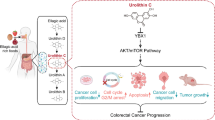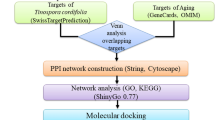Abstract
Patients with chronic pelvic inflammation (CPI) experience irregular menstrual, ectopic pregnancy, and infertility. Yiyi Baijiang Decoction attenuates CPI in patients with uncovered mechanisms. CPI therapeutic targets intersected with those of Yiyi Baijiang Decoction, followed by importing into STRING to obtain protein–target interaction. “Drug-component-disease-target” interaction was constructed by Cytoscape. mRNA and protein levels were detected by real-time quantitative PCR (RT-qPCR) and western blot. Yiyi Baijiang Decoction contained 199 active ingredients. There were 1071 drug targets for Yiyi Baijiang Decoction and 1622 therapeutic targets for CPI. The GO functional enrichment analysis revealed 3445 biological processes, and the KEGG pathway enrichment analysis screened 67 signal pathways. Decreased ALB, increased protein kinase B (AKT1), interleukin (IL)-6, vascular endothelial growth factor A (VEGFA), and phosphatidylinositol-4,5-bisphosphate 3-kinase (PI3K/AKT)-extracellular-regulated protein kinases (ERK)1/2 activation in CPI mice were abolished by Yiyi Baijiang Decoction. Yiyi Baijiang Decoction attenuates CPI by inactivating PI3K/AKT and ERK1/2 and regulating ALB, VEGFA, AKT1, and IL-6.








Similar content being viewed by others
Data Availability
The data used to support the findings of this study are available from the corresponding author upon request.
References
Chen L, Ma F, Yu L (2022) Implementation of comprehensive service in nursing care of patients with chronic pelvic inflammation and evaluation of its effect on quality of life. Minerva Surg 77(3):284–286
de Holanda AGB, da Silva Leite J, Consalter A, da Silva KVGC, dos Santos Batista BP, Fonseca ABM, Brandão FZ, Ferreira AMR (2019) Expression of interleukins 6 and 10 and population of inflammatory cells in the equine endometrium: diagnostic implications. Mol Biol Rep 46(2):2485–2491
Don BR, Kaysen G (2004) Serum albumin: relationship to inflammation and nutrition. Semin Dial 17(6):432–437
Fan LL, Yu WH, Liu XQ et al (2014) A meta-analysis on effectiveness of acupuncture and moxibustion for chronic pelvic inflammatory disease. Zhen Ci Yan Jiu 39(2):156–163
Fan L, Liu Z, Zhang Z et al (2022) Kangfuxiaoyanshuan alleviates uterine inflammation and adhesion via inhibiting NF-kappaB p65 and TGF-beta/MMP-2 signaling pathway in pelvic inflammatory disease rats. Front Pharmacol 13:894149
Feng XL, Jiang S, Chen J et al (2019) Effect of Fuyanshu capsules combined with antibiotics on inflammatory factors in patients with pelvic inflammatory disease. Zhongguo Zhong Yao Za Zhi 44(12):2637–2643
Gao S, Zhang Q (2017) Curative effect of **’gangteng capsule combined with Kangfuxiaoyan suppository in the treatment of chronic pelvic inflammatory disease. Pak J Pharm Sci 30:1943–1946
Hu P, Zhang S, Li H et al (2023) Association between dietary trace minerals and pelvic inflammatory disease: data from the 2015–2018 National health and nutrition examination surveys. Front Nutr 10:1273509
Hunt S, Vollenhoven B (2023) Pelvic inflammatory disease and infertility. Aust J Gen Pract 52(4):215–218
Interdonato L, Marino Y, D’Amico R et al (2023) Modulation of the proliferative pathway, neuroinflammation and pain in endometriosis. Int J Mol Sci 24(14):11741
Kilkenny C, Browne WJ, Cuthill IC et al (2012) Improving bioscience research reporting: the ARRIVE guidelines for reporting animal research. Osteoarthr Cartil 20(4):256–260
Li BS, Guo WJ, Hong L et al (2016) Role of mechanical strain-activated PI3K/Akt signaling pathway in pelvic organ prolapse. Mol Med Rep 14(1):243–253
Li Y, Yang Q, Shi ZH et al (2019) The anti-inflammatory effect of Feiyangchangweiyan capsule and Its main components on pelvic inflammatory disease in rats via the regulation of the NF-kappaB and BAX/BCL-2 pathway. Evid Based Complement Alternat Med 2019:9585727
Li XH, Liu YR, Jiang DH et al (2020) Research on the mechanism of Chinese herbal medicine Radix Paeoniae Rubra in improving chronic pelvic inflammation disease by regulating PTGS2 in the arachidonic acid pathway. Biomed Pharmacother 129:110052
Liu L, Yang F, **g Y, **n L (2019) Data mining in Xu Runsan’s traditional Chinese medicine practice: treatment of chronic pelvic pain caused by pelvic inflammatory disease. J Tradit Chin Med 39(3):440–450
Liu L, Yang G, Ren J et al (2022a) Analysis of infertility factors caused by gynecological chronic pelvic inflammation disease based on multivariate regression analysis of logistic. Scanning 2022:7531190
Liu H, Wang Z, **e Q et al (2022b) Ningmitai capsules have anti-inflammatory and pain-relieving effects in the chronic prostatitis/chronic pelvic pain syndrome mouse model through systemic immunity. Front Pharmacol 13:949316
Ma T, Liu P, Wei J et al (2021) Imperatorin alleviated endometriosis by inhibiting the activation of PI3K/Akt/NF-kappaB pathway in rats. Life Sci 274:119291
Park S, Lim W, Bazer FW et al (2019) Quercetin inhibits proliferation of endometriosis regulating cyclin D1 and its target microRNAs in vitro and in vivo. J Nutr Biochem 63:87–100
Peipert JF, Ness RB, Soper DE, Bass D (2000) Association of lower genital tract inflammation with objective evidence of endometritis. Infect Dis Obstet Gynecol 8(2):83–87
Price MJ, Ades AE, Welton NJ et al (2017) Pelvic inflammatory disease and sal**itis: incidence of primary and repeat episodes in England. Epidemiol Infect 145(1):208–215
Secord ER (1921) The treatment of acute pelvic inflammation in the female. Can Med Assoc J 11(12):910–913
Shi Z, Vasquez-Vivar J, Luo K et al (2018) Ascending lipopolysaccharide-induced intrauterine inflammation in near-term rabbits leading to newborn neurobehavioral deficits. Dev Neurosci 40(5–6):534–546
Shibuya M (2015) VEGF-VEGFR System as a target for suppressing inflammation and other diseases. Endocr Metab Immune Disord Drug Targets 15(2):135–144
Stehouwer CD, Gall MA, Twisk JW et al (2002) Increased urinary albumin excretion, endothelial dysfunction, and chronic low-grade inflammation in type 2 diabetes: progressive, interrelated, and independently associated with risk of death. Diabetes 51(4):1157–1165
Zhang LJ, Zhu JY, Sun MY et al (2017) Anti-inflammatory effect of Man-Pen-Fang, a Chinese herbal compound, on chronic pelvic inflammation in rats. J Ethnopharmacol 208:57–65
Zhang H, Wu ZM, Yang YP et al (2019) Catalpol ameliorates LPS-induced endometritis by inhibiting inflammation and TLR4/NF-kappaB signaling. J Zhejiang Univ Sci B 20(10):816–827
Acknowledgements
Not applicable.
Funding
The present study is funded by the Scientific Research Project of Hebei Provincial Administration of Traditional Chinese Medicine (2020282).
Author information
Authors and Affiliations
Contributions
YW, HS, YS, and MZ conceived and designed the experiments. YW, HS, JL, WZ, and LL carried out the experiments, analyzed the data, and drafted the manuscript. YW, HS, JL, and YS participated in its design and prepared the paper. YW, HS, YS, and MZ revised the manuscript. All authors read and approved the final manuscript.
Corresponding authors
Ethics declarations
Competing interests
The authors declare no competing interests.
Competing Interest
All authors have no financial, personal, or other relationships with others or organizations that could inappropriately influence the work.
Ethical Approval
Ethical approval for this study (SY2020-01) was provided by the Experimental Animal Ethics Committee of Hebei Ex&Invivo Biotechnology Co., Ltd on 10 February 2020.
Consent for Publication
We confirm that the manuscript has been read and approved for publication by all named authors and that there are no other persons who satisfied the criteria for authorship but are not listed.
Informed Consent
The present study followed international, China and Hebei Ex&Invivo Biotechnology Co., Ltd guidelines for humane animal treatment and complied with relevant legislation.
Additional information
Publisher's Note
Springer Nature remains neutral with regard to jurisdictional claims in published maps and institutional affiliations.
Supplementary Information
Below is the link to the electronic supplementary material.
Rights and permissions
Springer Nature or its licensor (e.g. a society or other partner) holds exclusive rights to this article under a publishing agreement with the author(s) or other rightsholder(s); author self-archiving of the accepted manuscript version of this article is solely governed by the terms of such publishing agreement and applicable law.
About this article
Cite this article
Wei, Y., Su, H., Li, J. et al. Exploration into the Mechanism of Yiyi Baijiang Decoction Attenuating Chronic Pelvic Inflammation Based on Network Pharmacology and Experimental Verification. Biochem Genet (2024). https://doi.org/10.1007/s10528-024-10843-0
Received:
Accepted:
Published:
DOI: https://doi.org/10.1007/s10528-024-10843-0




